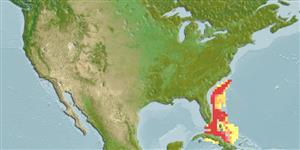分類 / Names
俗名 | 同種異名 | Catalog of Fishes(屬, 種) | ITIS | CoL | WoRMS | Cloffa
Elasmobranchii
板鰓亞綱 (鯊魚與魟魚) (sharks and rays) >
Torpediniformes (Electric rays)
電鰩目 (Electric rays) >
Narcinidae (Numbfishes)
雙鰭電鰩科 (Numbfishes)
Etymology: Benthobatis: Greek, benthos = depth of the sea + Greek, batis, -idos = a ray (Raja sp.) (Ref. 45335); marcida: From its loose skin and soft aspect ['marcidus' = withered or wasted]..
Environment: milieu / climate zone / depth range / distribution range
生態學
海洋 深海底的; 深度上下限 200 - 923 m (Ref. 48493). 深水域; 34°N - 21°N, 82°W - 74°W (Ref. 114953)
Western Central Atlantic. South Carolina, USA to northern Cuba.
中西大西洋。 美國南卡羅萊那州到古巴北部。
大小 / 重量 / 年齡
Maturity: Lm ? range ? - ? cm
Max length : 50.0 cm WD 雄魚/尚未辨別雌雄; (Ref. 26340)
簡短描述
型態特徵 | 形態測量圖
Narrow protractile mouth. Caudal is oval shape. Greater length of head anterior to spiracles, union of margins of its pelvic fins to their tips with the sides of the tail. Soft body and skin (Ref. 6902). Light brown to yellowish-brown dorsal color pattern; white to yellowish-white ventral color pattern, sometimes with distinct yellow markings on posterior ventral disc surface, ventral pelvic fin area, and around mouth. Caudal fin length much less than 1/2 length of tail, roughly equal to 1/5 length of tail; relatively more pronounced upper and lower lobes with lower strongly convex. Distance between dorsal and caudal fins about equal to distance between first and second dorsal fins. Snout relatively short, generally less than 1/3 in disc-length (24% of disc length in 43.5 cm TL female, 25% in 48.5 cm TL), but never much greater than 1/3 as in B. moresbyi (ca 40% in lectotype); disc more rounded, not as elongated as in B. moresbyi (Ref. 48493).
狹窄的可伸出的嘴。 尾部的是橢圓形的形狀。 較大的頭長位於呼吸孔前, 具有尾部的側邊的他們的頂端的它的腹鰭的邊緣融合處。 軟的身體與皮膚.(參考文獻 6902) 淡褐色到土黃色背部的色彩; 白色到黃白色腹的彩色斑紋,有時有明顯的黃色斑紋在後部的腹體盤表面,腹面腹鰭區域, 與嘴的周圍。 尾鰭長度遠小於 1/2個尾長, 概略地等於 1/5個尾長; 相對較多的明顯上葉與下葉具有低的強烈中凸。 背鰭與尾鰭鰭大約等於之間的距離第一個之間的距離與第二背鰭鰭。 吻相當短的, 通常少於 1/3 在體盤長 (在 43.5個公分TL 母魚中的 24% 的體盤長度, 在 48.5 公分TL 中的 25%), 但是從不大於 1/3 當在 B. moresbyi 中;(ca 40% 在選模式) 體盤更圓形的, 不那般瘦長 B. moresbyi.(參考文獻 48493)
Inhabits neritic waters, on sandy bottoms (Ref. 557). Found on continental and insular slopes at 250-1,000 m depths; adults apparently at greatest depths (Ref. 114953). Solitary. Tiny eyes are covered with skin so that the species is blind (Ref. 557). Feeds on marine invertebrates. Both ovaries are functional in an adult female, with numerous small oocytes of ca. 2 mm in thin-walled uteri. Maturity size of males at ca. 16 cm TL; birth size at 8-9 cm TL (Ref. 114953).
在砂質底部上,棲息於淺海的水域。 獨居性。 極小的眼被覆蓋著皮膚,所以此魚種是盲眼的。 (參考文獻 557)
Life cycle and mating behavior
成熟度 | 繁殖 | 產卵場 | 卵 | 孕卵數 | 仔魚
中西大西洋。 美國南卡羅萊那州到古巴北部。
Claro, R., 1994. Características generales de la ictiofauna. p. 55-70. In R. Claro (ed.) Ecología de los peces marinos de Cuba. Instituto de Oceanología Academia de Ciencias de Cuba and Centro de Investigaciones de Quintana Roo. (Ref. 26340)
人類使用
漁業: 沒有興趣
更多資訊
參考文獻養殖養殖資訊品種遺傳學Electrophoreses遺傳率疾病加工NutrientsMass conversion
合作者照片Stamps, Coins Misc.聲音神經毒速度泳型鰓區Otoliths腦重體重比眼睛色素
工具
特別的報告
下載 XML
網路資源
Estimates based on models
Preferred temperature (Ref.
123201): 8.8 - 18.2, mean 13 °C (based on 77 cells).
Phylogenetic diversity index (Ref.
82804): PD
50 = 0.5625 [Uniqueness, from 0.5 = low to 2.0 = high].
Bayesian length-weight: a=0.01175 (0.00476 - 0.02897), b=2.88 (2.66 - 3.10), in cm total length, based on LWR estimates for this (Sub)family-body shape (Ref.
93245).
營養階層 (Ref.
69278): 3.2 ±0.4 se; based on size and trophs of closest relatives
回復力 (Ref.
120179): 低的, 最小族群倍增時間4.5 - 14 年 (Assuming fecundity<100).
Fishing Vulnerability (Ref.
59153): Low vulnerability (20 of 100).
